Back to page 1
The Design

Smith spoke with us about a guiding principle at play in the park’s design. “A Triple-A ballpark is supposed to have a capacity of 10,000, but Larry (Lucchino) wanted only 6,000 permanent seats, with the remaining capacity being more flexible.” Indeed, the main seating bowl relies on a geometry that keeps the vast majority of permanent seats in the infield — and close to the field. As you extend toward both foul lines, there are multiple areas where groups can congregate or individual fans can stand or sit as they choose. Sounds pretty flexible to me. Of course, social interaction is maximized this way, which is the trend in modern-day ballpark design.
Down the left-field line are two group areas, one on top of the other. The uncovered upper level is the Hanover Deck (shown in the photo below with the red umbrellas — which are just as handy when it’s raining as when the sun is beating down). The way this area is angled toward the infield makes for a tremendous view here, plus groups renting this space can access the buffet in Suite 1 through a sliding glass door. The lower (covered) area is the Shaw’s 3rd Base Bullpen Terrace (other photo below). Each level can hold up to 225 guests. The Shaw’s 1st Base Bullpen Terrace overlooks the home bullpen, and can accommodate up to 100 fans. In right center field is the FLEXcon Landing, which can also hold 100.
 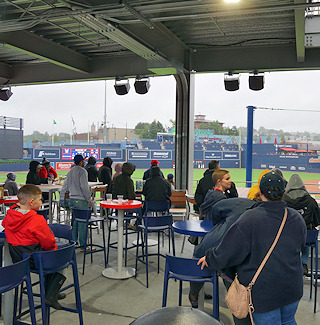 |
There is also the Right Field Party Deck that can hold 400 and the Craft (as in beer) Corner with a capacity of 150.
For non-gameday events, the WooSox even rent out the home and visitors’ clubhouses and indoor batting tunnels.

The geometry of the seating bowl deserves mention, because it’s different than at most modern-day parks, which tend to curve around home plate. Here the front of the stands are perfectly perpendicular to a line that would stretch from home to dead center field. Smith notes that this is how Ebbets Field was configured, with angles between the seating sections, not curves. At Polar Park, this geometry is repeated in the upper-level seats in the infield (see the photo above), and even in the very straight roof elements. This adds to the intimacy of the ballpark, and places the backstop at a very close 45 feet from home plate. Baserunners need to be cautious when there’s a wild pitch that goes all the way to the backstop, because the catcher isn’t that far away.
 Let’s talk about another interesting element in the seating bowl. Do you know what an “end standard” is? D.J. Thomas of Younts Design in Baltimore has worked with Smith on every ballpark she’s done since Atlanta’s Turner Field in the 1990s. He explained that an end standard is the design that is at the end of each row of seats. To create the design for Polar Park’s rows of seats, they examined the emblem used by the Worcester Worcesters in the 1880s. Theirs showed a heart over crossed bats, with their manager’s face at the center. Well, the face wouldn’t make sense today, so it was replaced by a “W.” The “W” in today’s logo was adapted from the 140-year-old Worcesters’ logo.
Let’s talk about another interesting element in the seating bowl. Do you know what an “end standard” is? D.J. Thomas of Younts Design in Baltimore has worked with Smith on every ballpark she’s done since Atlanta’s Turner Field in the 1990s. He explained that an end standard is the design that is at the end of each row of seats. To create the design for Polar Park’s rows of seats, they examined the emblem used by the Worcester Worcesters in the 1880s. Theirs showed a heart over crossed bats, with their manager’s face at the center. Well, the face wouldn’t make sense today, so it was replaced by a “W.” The “W” in today’s logo was adapted from the 140-year-old Worcesters’ logo.
So when you come to a Worcester Red Sox game, take a moment, stoop down and really look at the end standard at the end of your row. And point it out to your fellow fans, noting that this is an “end standard,” influenced by the Worcester Worcesters’ 1880 emblem. They’ll no doubt think you’re really smart … or that you spend too much time reading lengthy ballpark reviews.
Although not incorporated into the park’s end standards, there is a modern-day touch added to that “W” when used elsewhere: a small heart was put in the middle, to tie into the city’s slogan about being in the Heart of the Commonwealth.
There’s a field-level suite adjacent to the home dugout on the first base side. It’s called the Big Blue Bug Batter’s Box, and can hold up to 15 fans. This pushes the dugouts down the foul lines farther than at other ballparks – so much so that pitchers can go directly from the far end of the home dugout into the bullpen without having to walk onto the playing surface.
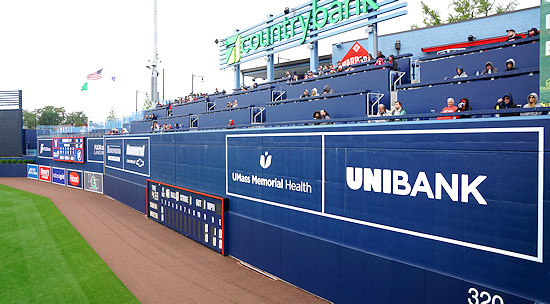
At Fenway, the most popular seats are atop the 37-foot-tall Green Monster. Polar Park’s equivalent is the blue Worcester Wall (unlike at Fenway, this is truly a retaining wall, plus it’s in right field, not left), and there are four rows of seats here. The top of this wall is 22 feet above the field, which makes for a really nice view of the action – better than the Monster Seats in Boston.
I like that the outfield dimensions lack the in-and-out-and-in-and-out of the OF walls in places like Rocket City. At 399 feet, the deepest part of left-center field is farther away from the plate than at most parks, but that’s so that a football field will fit. It would run parallel to the left-field foul line. Holy Cross, in fact, is scheduled to play a home game here this fall.
There is a problem, though, on the uppermost level of the concourse behind the Worcester Wall. Close to the outer perimeter of the ballpark, the ground is not paved. Instead of concrete, there is crushed black gravel, much like the warning track in outfields. Perhaps because of the rain, this material was sticking to fans’ shoes and being tracked into the seating areas on top of the Wall and down the concourse toward the main seating bowl. Ushers were present to urge fans not to walk on this material and, instead, stay on the paved areas. That’s certainly not a long-term solution, but I’m told the team is aware of this messy issue and is working on fixing it.
Moving to the upper level above the main seating bowl, all I can say is that this area is fantastic. While the suites stretch down the foul lines, the area directly behind home plate is the spacious DCU Club (photo below). If an entity rents it out for an event when a game isn’t going on, it will accommodate 300 people. There are seats in front of it — out in the elements, of course — where the sections mirror the angling of the seating sections below. This isn’t typical, but the sight lines are excellent.
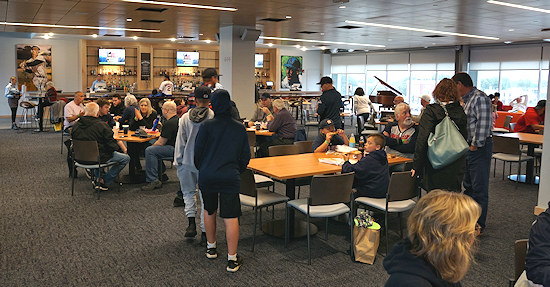
As mentioned, the preponderance of social gathering spaces in Polar Park follows a modern trend, but there’s a feature that bucks all current ballpark-design thinking: the number of upper-level suites. The recent trend has been to reduce the number, but in Worcester, there are a whopping 22. That’s the most in a new Minor League park since Las Vegas Ballpark also opened with 22 in 2019. It appeared to me that the WooSox were successful renting out their suites, with two being held back for single-game rentals – so they certainly didn’t overbuild when it came to suites.
One of the truly unique features of Polar Park can be found on the field side of the DCU Club. Here there are three glass-enclosed broadcast booths, with a large center booth for TV broadcasts, while the radio play-by-play announcers are in the outer two. This arrangement checks a lot of boxes: it gives the broadcasters a fantastic view of the field from directly behind home plate; it allows fans in the Club to watch the broadcasts in action; it provides natural light through all the glass; and because the doors to enter the radio booths are outside of the Club next to the seats, it prevents people in the Club space from barging into the radio play by play (which evidently is more important than people interrupting telecasts, because the TV space’s doors do open into the Club).

In case you’re wondering, the “working press” (non-broadcasters) area is separate. It’s still on the upper level, but behind third base.
The upper level even has its own “farm” where veggies and spices are grown, known as Harvard Pilgrim Health Gardens. This concept is borrowed from the Fenway Farm in Boston.
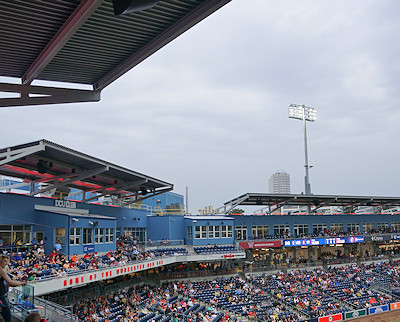 There is indeed a roof over the upper level, but it’s what Quirk refers to as a “discontinuous roof.” At most ballparks, the roof stretches continuously around from the first-base side to the third. This is what the early renderings showed for Polar Park (along with the brick façade). However, the finished product is in three different sections, each perfectly straight. This allows these roof sections to mirror the straight lines of the stands down on the field level. Even though this leaves gaps where the fans are left without shade and/or protection from the rain, I liked this look a lot.
There is indeed a roof over the upper level, but it’s what Quirk refers to as a “discontinuous roof.” At most ballparks, the roof stretches continuously around from the first-base side to the third. This is what the early renderings showed for Polar Park (along with the brick façade). However, the finished product is in three different sections, each perfectly straight. This allows these roof sections to mirror the straight lines of the stands down on the field level. Even though this leaves gaps where the fans are left without shade and/or protection from the rain, I liked this look a lot.
“It was an architectural decision to do this,” Quirk said. “We thought it would be iconic and unique, so that any photo of the park would be instantly identifiable as Worcester.”
Another feature unique to this park is the shape of the two banks of lights on the standards in the outfield (photo below, provided by Tommy Quirk). Each is in the shape of a heart. They say you really notice the shape of these lights when you are a couple of blocks away from the park on the north side, looking back toward the park’s outfield at night.
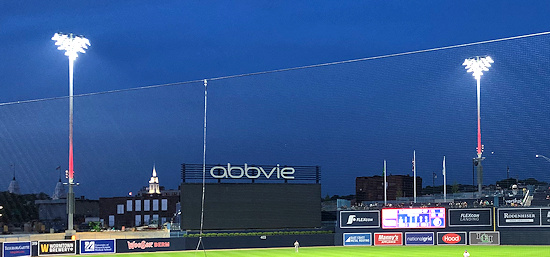
By the way, before visiting Polar Park, I’d read some complaints about the sightlines there, so I was on the lookout for places where fans couldn’t see all of the field. What I found was that the sightlines are as good as at any park, and better than most. The only thing I noticed was that the scoreboard isn’t exactly where you might think it would be. It’s in left field, parallel to the train tracks. This involved thinking ahead, because it is positioned so that people in the stands will clearly be able to see the Left Field Building, and more importantly, it maintains a great view of the field from the rooftop terrace that will be on top of that structure.
In fact, the entire layout of the ballpark showed tremendous planning … just as you would expect when Janet Marie Smith is involved!
The Essentials

So the architecture is tremendous, but what is it like to attend a game here?
I mentioned that the parking is pretty tight, so unless you arrive really early, you should look on the west side of the train tracks. Parking prices vary from $5 to $15 (which assuredly beats the $50-$60 charged near Fenway!).
Except for General Admission tickets (which are $9, or a dollar less if you’re a child, senior citizen or active duty or retired military), all of the tickets are two dollars cheaper if you purchase them before the day of the game. These prices are when purchased in advance: a seat in front of the upper level DCU Club is $40, as are seats right along the backstop; seats in the three sections directly behind home plate are $27; on top of the Worcester Wall, tickets are $21; other reserved seats in the infield are $21; in the last two sections down the left-field foul line before you reach the visitors’ bullpen, seats are $15.
All of these prices are exactly what you would expect in a brand-new Triple-A ballpark.
If you pay $9 for a general admission ticket, you will be delighted to discover that there are endless possibilities where you can watch the game. In fact, scattered all around the park are tables and counters with red stools (like in the shot at the top of this section). Any time you spot an unoccupied red stool or chair – even right behind home plate – you can sit in it. Note that there are also blue stools, but those are reserved seating positions. Whenever you see red, though, someone with a GA tickets can sit down there.
I’ve never seen that concept in a ballpark before, and I love it.
While the team’s Cap Car is available in the outfield for caps and t-shirts, the main store (photo below) is down on street level, behind home plate. That means you might want to hit it on your way into the park or when leaving. The store is huge, so unlike a lot of stores in ballparks, you never feel crowded.
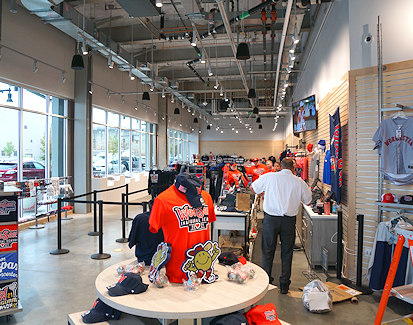  |
While it bothered me that some items didn’t have a price on them at all (particularly some of the caps), the selection of team merchandise was very good – and even included some merch for Worcester’s hockey team, the Railers.
Adult WooSox t-shirts were very reasonably priced at $20 and $22, while long-sleeve tees were $25-28. There was an adult jersey top for $99, and hoodies at $45. There was one type of polo, and it cost only $30. Women’s tees were $28. There were caps just for women priced at $22. Other adult caps were $22 for adjustable models and $28-34 for fitted. Kids caps were $18.
Considering this is a new franchise, and one at the Triple-A level to boot, these prices are very reasonable.
Where the store really shines, though, is in really cute novelty items. The team’s merchandise manager Kat Burns did a very good job in ordering. What was in short supply, though, was my favorite novelty item: lapel pins. Pins showing the team’s cute logo were sold out, and only a few were left that said POLAR PARK on them. Naturally, I bought one immediately. Cost: $6.
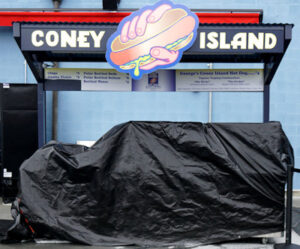 As far as concessions go, the team and its food-service partner PSC did a phenomenal job of partnering with local eateries to sell their menu items at the park. I’m told by far the most popular food item in the park are the $4 hot dogs at the Coney Island stand-alone stand in right field. You couldn’t prove it by me, though, because the stand was closed all three days I attended WooSox games. I was told that the health department won’t allow stands like this to be open in rainy weather. I think for 2022, the team should work hard at placing Coney Island’s stand on the main concourse somewhere so it won’t be open to the elements.
As far as concessions go, the team and its food-service partner PSC did a phenomenal job of partnering with local eateries to sell their menu items at the park. I’m told by far the most popular food item in the park are the $4 hot dogs at the Coney Island stand-alone stand in right field. You couldn’t prove it by me, though, because the stand was closed all three days I attended WooSox games. I was told that the health department won’t allow stands like this to be open in rainy weather. I think for 2022, the team should work hard at placing Coney Island’s stand on the main concourse somewhere so it won’t be open to the elements.
Near the Coney Island stand in the right-field corner is B.T.’s Smokehouse in a permanent cinder-block structure. Here they serve their own barbecued pulled pork, chicken and brisket. They serve mammoth amounts on a sandwich for $14, or a “mini sandwich” for $8. They also serve “Southern Sides” – mac ‘n cheese, potato salad and slaw.
Another local eatery with a stand is Wonder Bar Pizza, behind first base. They sell huge slices for $8, a personal (round) pizza for $12 and if you want an entire 18-inch pizza, they make it for you for $38.
For sale for $2 at a number of stands are the mini-size pies from Table Talk Pies – baked just a few hundred feet from the ballpark.
There are two permanent stands behind home plate. Infield Fry offers chicken tenders ($9), boneless wings ($11) and a grilled chicken sandwich ($11), all served with fries. Behind The Plate features a vegetarian black bean burger (with fries for $11), a 1/3-pound cheeseburger ($6), and a ½-pound WooBurger with cheese, pastrami, grilled onions and spicy mustard (with fries for $11).
The stands behind third base feature nachos, dogs, sausages, and ice cream.
Don’t forget the Craft Corner near the right-field foul pole. Here craft beers in 20-ounce souvenir cups are $11, hard seltzers are $10 and 24-ounce domestic beers in cans are $9.
  |
You definitely need to visit the WooSox Market (photos above), located on the main concourse behind the first-base on-deck circle. There are pre-packaged salads, deli sandwiches and wraps, snacks, bottled drinks of every type, and cans of Wormtown Brewery’s Don’t Worry Hazy IPA and Be Hoppy Pale Ale. Both cans, of course, feature the smiley face created by (as mentioned earlier) Worcester’s Harvey Ball.
And the best thing about the WooSox Market? Once you (and your credit card) are in their system, you won’t have to check out at a register. You grab whatever you want and head back to your seat. This is very much like the Amazon Go convenience stores popping up in major cities.
Now, if you’re wondering whether this is a Coke park or a Pepsi park … it’s neither. In case you don’t live in New England, you probably aren’t aware of the Polar brand of beverages. While you might have seen their bottled spring water, you probably haven’t seen their colas, root beers, ginger ales and seltzers. Well, those are the sodas sold at the ballpark that carries their name. I’d never seen them before, but I have to admit that their drinks are awfully good. My favorite was their Sparkling Orange Dry beverage.
I was also able to try some of the food items served on the upper level, the best of which was a lobster roll that was as delicious and meaty as I’ve ever had – and that includes on the coast of Maine. I was told the team might start serving this delectable lobster roll at stands downstairs on the main concourse. It will be expensive (it was $24 upstairs), but it’s worth it. If it’s available when you attend a WooSox game, splurge.
Kids not only like the play area on the far side of the batter’s eye, they also love the team’s mascot: Smiley Ball. Yes, he’s round and yellow, and has the same last name as his creator, the aforementioned Harvey Ball. You’ll find a cartoon version of this as a logo on caps, shirts and an exterior (blue, of course) wall. The smiley face swinging a bat is undoubtedly the most popular version of this iconic image to WooSox fans.
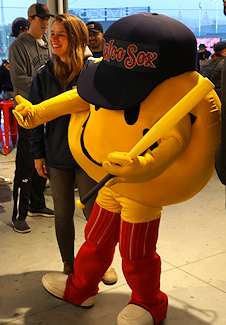  |
As you wander around this ballpark, you’ll notice artistic flourishes simply everywhere, including the halls of the upper level if you’re lucky enough to visit there. I don’t mean pieces of art like at Wichita’s park, where the city requires every building project to devote part of its budget to art. No, the art here fits – it fits Worcester, it fits baseball, and it fits the legacy of Harvey Ball.
 For instance, as you reach the top of the stairs from the lobby to the upper level, you’ll notice a life-size statue of Mighty Casey wearing his Mudville Nine uniform, from the 1888 poem Casey at the Bat. The entire poem is framed next to Casey, and on the nearby landing is a painting showing him and his teammates mentioned in the poem. You might know that the poet was Ernest Thayer, but I bet you didn’t know that Thayer grew up in, of course, Worcester.
For instance, as you reach the top of the stairs from the lobby to the upper level, you’ll notice a life-size statue of Mighty Casey wearing his Mudville Nine uniform, from the 1888 poem Casey at the Bat. The entire poem is framed next to Casey, and on the nearby landing is a painting showing him and his teammates mentioned in the poem. You might know that the poet was Ernest Thayer, but I bet you didn’t know that Thayer grew up in, of course, Worcester.
As far as the scoreboard, video boards and sound system go, I thought they were all state-of-the-art.
While the rainy weather might’ve put a damper on the gameday promotions and games that I was able to witness, I felt that the WooSox’ approach was more on the professional side (think Wichita) than the zany, madcap side (think Rocket City). I have no complaints, though, about how the team handles such things.
In fact, I have no complaints about the prices or concessions, and precious few complaints about the ballpark’s design. This place is a winner.
Summary

As mentioned, Charles Steinberg has been with Larry Lucchino in Baltimore, San Diego, Boston and now is team president in Worcester.
When it became apparent that the franchise was moving from Pawtucket to a new park in Worcester, Steinberg started conducting “Fan Plan Meetings.” He held them at schools, large employers, civic events, Little League banquets, you name it. In all, he conducted 21 of these meetings. The purpose was to collect suggestions from fans about what they wanted in the new ballpark. The first meeting was on October 16, 2018, and the last one was March 5, 2020.
And he took copious notes.
Here are some examples: “Please partner with local restaurants.” Have an “architectural resonance with Worcester – like Higgins steel.” The staff should be “accommodating and friendly.” “Please open the door to opportunities for partnerships with small businesses.” “Be sure to provide Latino food.”
Every single suggestion – even if it was one that had been made multiple times previously, and even if it was one that the team had already rejected – was carefully written down in a blue notebook by Steinberg. And his handwriting was absolutely impeccable.
Did these suggestions have any impact? “Dozens of ideas from that blue notebook made it into the park,” says Lucchino.
You can’t say that the team was oblivious to what the fans wanted. Indeed, Polar Park is full of tremendous ideas and innovations. It’s a ballpark with many brilliant features, but it’s also one where the features work together to make a tremendous whole. And it has instantly zoomed toward the top of the list of facilities in the Minors.
When I asked Steinberg for his favorite feature of Polar Park, he said, “There are a lot, but here are my nominees: The 1880 Worcester Worcesters’ logo that we used in the end standards; the heart-shaped lights in the outfield; the color scheme; the proximity of the stands to the field; the intimacy created by the intersection of the stands and walls, fitting together like jigsaw puzzle pieces. But best of all is the animation of the physical space by the fans.”
Steinberg sums up Polar Park like this: “It’s a happy little ballpark. It’s a friendly little ballpark. It feels like the long-awaited community gathering place that Worcester has longed for. It feels like a city that has come together in joy.”
Tell us what you think of this review or of Polar Park in the comments box below.
A+
Come back when it’s sunny.
The first 5 are on me.
Great review including a history of Worcester and how they have pulled it all together in Polar Park